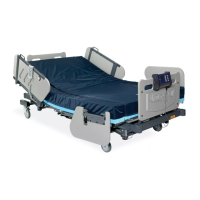12 TRI-FLEX II BED - OPERATION MANUAL
Operational Instruction
TRANSPORTING THE BED & PATIENT
To transport a patient on the Tri-Flex II bed:
1) Adjust head elevation to the desired position for
patient comfort.
•Maximumpatientweightinbedfortransport
is454kg(1000lbs).
2)
WARNING: To ensure patient safety, the height of the bed should
be lowered to its lowest position. (See Figure 7)
3) Ensure side rails are locked in an upright position.
4) Use an IV pole to mount solutions.
5)UnplugthebedACpowercable;wraptheACpowercablearoundcableholderbeneaththe
head board. Automatic battery power will temporarily allow the use of all bed functions until
AC power is restored.
6) Unlock the two head end caster locks and one foot end caster lock. This will leave you with one
directional lock caster (caster with green brake tab) engaged to assist in transport down a hall.
7) Use a minimum of two persons to transport the patient.
Check the bed width and side rail adjustment for doorway clearance to prevent damage to the
bed and door frames.
WARNING: Keep hands and feet clear of wheels during bed movement. Move the bed only
at a slow walk.
WARNING: Moving bed down inclines or excursion off a ledge (such as moving into an
elevator or across a threshold) can result in damage to the bed and injury to persons.
WARNING: DO NOT PULL OR PUSH ON HEAD GATCH
TO MOVE THE BED.
Figure 7
!
!
NOTE: Remember to plug the Tri-Flex II bed into the
wall outlet once transport of the bed is complete.
PATIENT TRANSFERS (from or to the bed)
1) Set the brake on all casters with spring locking lever pointing towards the foot end of the bed.
2) Adjust the height of the bed to match transfer height, It is best to always transfer down.
3) Lower the side rails or remove them.
4) Use a hospital sheet and appropriate number of personnel to lift the patient on/off the bed.

